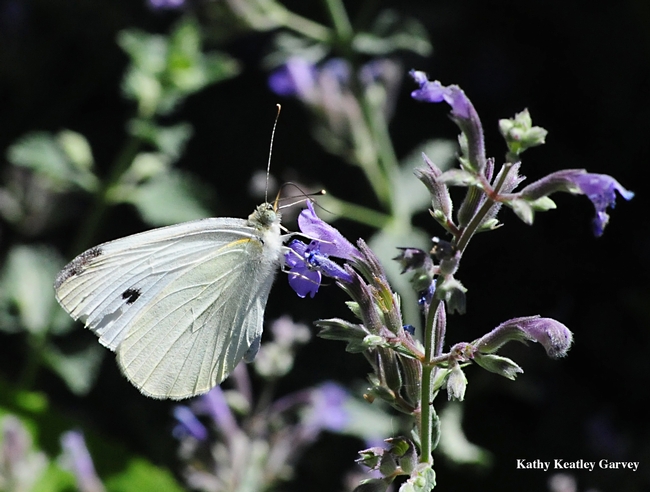- Author: Kathy Keatley Garvey
Have you seen any Checkered White butterflies lately?
They're quite common in the southern United States and northern Mexico (they're known as the Southern cabbage butterfly), but one CW fluttered through our pollinator garden in Vacaville, Solano County, Calif., on June 23.
It's in the same family, Pieridae, as the cabbage white butterfly, Pieris rapae.
This one, a female Pontia protodice, as identified by butterfly guru Art Shapiro, UC Davis distinguished professor of evolution and ecology, seemed to like our lavender.
"There was one laying eggs at Gates Canyon (Vacaville) two weeks ago," Shapiro noted. "This is an immigrant, which occasionally overwinters here--not very recently, though. It lives in the desert, both in SoCal and in Nevada. I don't know which direction these are coming from."
He reported two recently at Lang Crossing (Nevada County) on the Sierran West slope at 5000 feet. "This is probably a significant incursion."
He saw "scads of them" on June 30 in Rancho Cordova (Sacramento County)--clearly breeding there!"
The Checkered Whites "tend to fly in a straighter line than rapae, like it's late for an important date," he quipped. The females have more extensive markings than the males.
On his website, Art's Butterfly World, he points out that:
"In the 1970s this species was often abundant at low elevation along the transect, overwintering only locally and sporadically-mostly on dredge tailings along the American River. It has since become much rarer and in most years is seen only in September and October. At Sierra Valley it overwinters unpredictably but colonizes each year from the desert in May or June, and usually becomes common by late summer. It has been recorded at all sites but is not a permanent resident at any of them at this time!"
"A highly vagile species, the Checkered White breeds on a great variety of Brassicaceous plants, preferring smaller and unsucculent species such as Peppergrasses (Lepidium, but L. latifolium is unpreferred), Tumble Mustard (Sisymbrium altissimum), and the short-lived perennial Hirschfeldia incana (formerly called Brassica geniculata). The eggs are orange, laid conspicuously near the top of the plant, and the larvae, which are striped lengthwise in whitish yellow and greenish gray, feed primarily on buds, flowers and fruit. However, eggs are also often laid on small rosettes, especially if the larger plants in the area are senescent. This is overwhelmingly a species of grassland and steppe and occurs in wooded areas only along roadsides."
Shapiro, who has been monitoring the butterfly population of central California since 1972, says the Checkered White adults visit mustards, composites, legumes "and almost anything else; they are often abundant in irrigated alfalfa and visit its flowers freely. Males patrol in host-plant areas and often mate with teneral females."
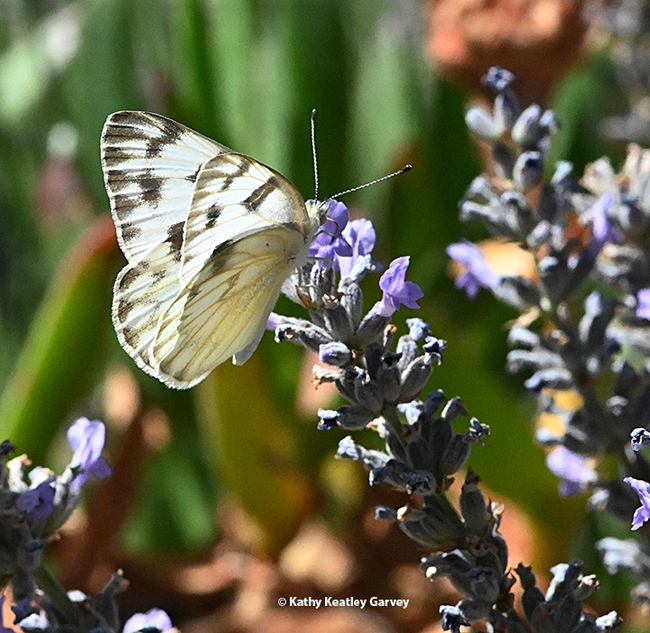
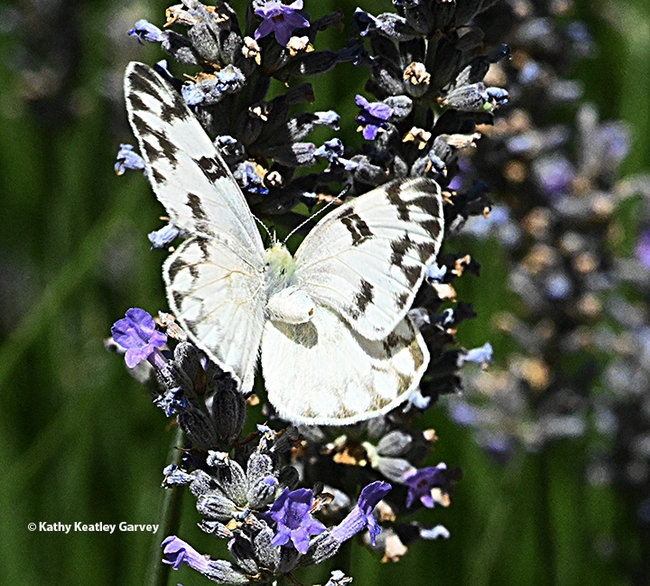
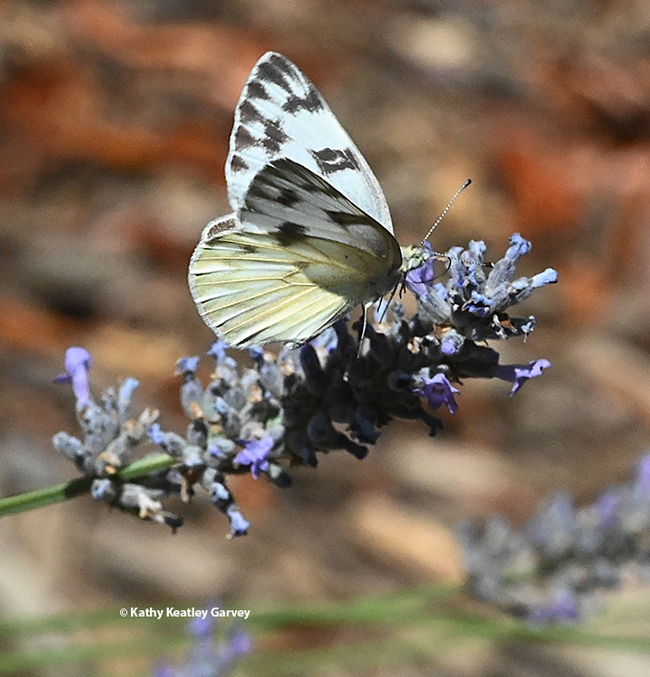
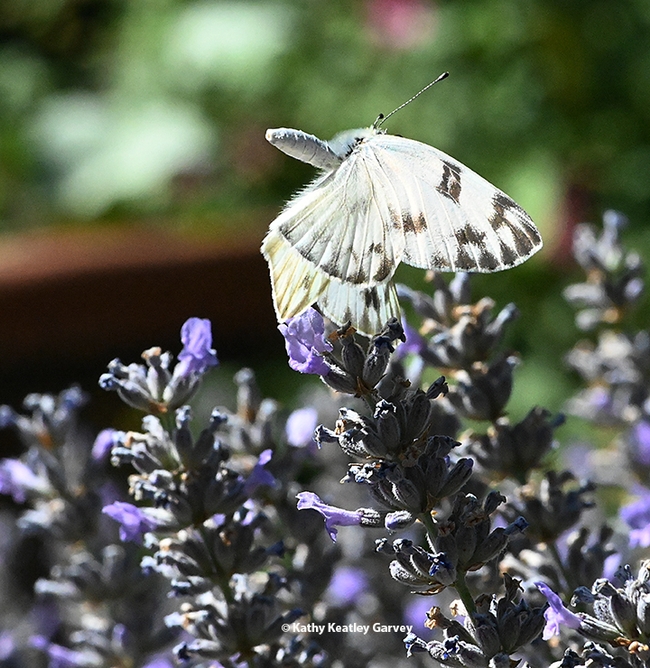
- Author: Kathy Keatley Garvey
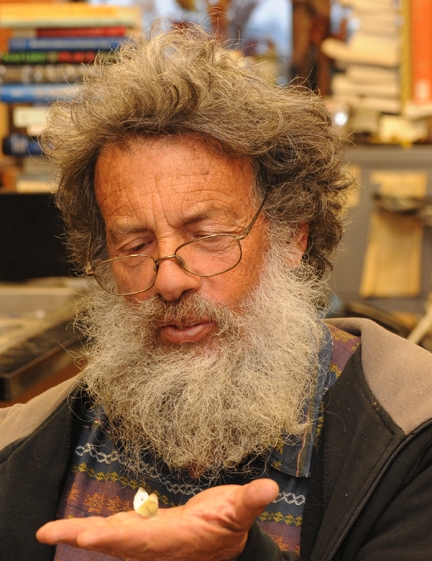
If you're out and about on Jan. 1, start looking for that cabbage white butterfly. But you're going to have to beat the sponsor, noted butterfly expert Art Shapiro, UC Davis distinguished professor of evolution and ecology.
Shapiro is offering a pitcher of beer (or its equivalent) for the first cabbage white butterfly (Pieris rapae) collected in 2017 in the three-county area of Sacramento, Yolo and Solano.
The 2016 winner was UC Davis ecology graduate student Jacob Montgomery who caught a female cabbage white butterfly on Jan. 16 on his lavender plant just outside his front door in west Davis, Yolo County.
“It was cold and rainy and the butterfly's wings looked bent like it had just hatched,” recalled Montgomery, whose grad student studies involve phytoplankton and zooplankton dynamics in the Delta. “It was not difficult to catch. I picked it up by hand…I had been aware of the contest but not actively searching for the butterflies. It was completely opportunistic.”
The 2016 prize winner probably eclosed or hatched around 7:30 that morning, said Shapiro, who has earlier predicted that the first butterfly of 2016 would be collected in mid-January.
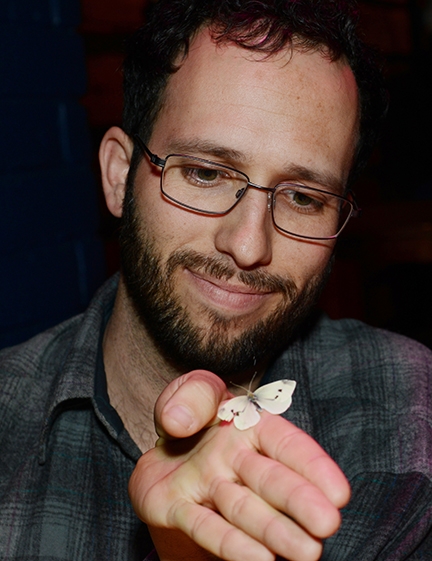
The butterfly is emerging earlier and earlier as the regional climate has warmed, said Shapiro, who does long-term studies of butterfly life cycles and climate. "Such studies are especially important to help us understand biological responses to climate change. The cabbage white is now emerging a week or so earlier on average than it did 30 years ago here."
The professor, a fellow of the American Association for the Advancement of Science, the Royal Entomological Society and the California Academy of Sciences, said the cabbage white butterfly inhabits vacant lots, fields and gardens where its host plants, weedy mustards, grow.
What does it look like? It's a white butterfly with black dots on the upperside (which may be faint or not visible in the early season). It inhabits vacant lots, fields and gardens where its host plants, weedy mustards, grow.
The male is white. The female is often slightly buffy; the "underside of the hindwing and apex of the forewing may be distinctly yellow and normally have a gray cast,” Shapiro said. “The black dots and apical spot on the upperside tend to be faint or even to disappear really early in the season.”
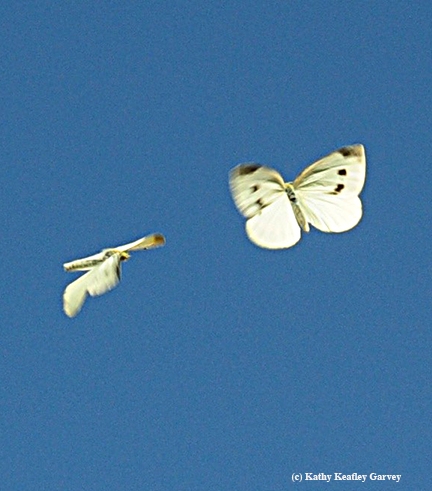
- It must be an adult (no caterpillars or pupae) and be captured outdoors.
- It must be brought in alive to the department office, 2320 Storer Hall, UC Davis, during work hours, 8 a.m. to 5 p.m., Monday through Friday, with the full data (exact time, date and location of the capture) and your name, address, phone number and/or e-mail. The receptionist will certify that it is alive and refrigerate it. (If you collect it on a weekend or holiday, keep it in a refrigerator; do not freeze. A few days in the fridge will not harm it.)
- Shapiro is the sole judge.
Shapiro, who is in the field more than 200 days of the year, monitoring butterflies of central California, knows where to find the cabbage whites and usually returns to his office with the first cabbage white of the year. He has been defeated only four times since 1972. Three winners were his own graduate students: Adam Porter defeated him in 1983; and Sherri Graves and Rick VanBuskirk each won in the late 1990s.
Shapiro has collected many of his winners in mustard patches near railroad tracks in West Sacramento, Yolo County. Over the last seven years, five of the winners came from West Sacramento; one in Davis, Yolo County; and one in Suisun, Solano County.
- 2016: Jan. 16: Jacob Montgomery collected the winner in west Davis
- 2015: Jan. 26: Art Shapiro collected the winner in West Sacramento
- 2014: Jan. 14: Shapiro collected the winner in West Sacramento
- 2013: Jan. 21: Shapiro collected the winner in West Sacramento
- 2012: Jan. 8: Shapiro collected the winner in West Sacramento
- 2011: Jan. 31: Shapiro collected the winner in Suisun, Solano County
- 2010: Jan. 27: Shapiro collected the winner in West Sacramento
Coincidentally, Shapiro caught the 2013 and 2009 winners on President Obama's Inauguration Day. After catching the 2013 winner, he quipped: "The constitution mandates the swearing-in for Jan. 20, though it does not require Pieris rapae to emerge on that date! Thank you, Mr. President.”
Shapiro maintains a website on butterflies at http://butterfly.ucdavis.edu/, where he records the population trends he monitors in Central California. He and artist Tim Manolis co-authored A Field Guide to Butterflies of the San Francisco Bay and Sacramento Valley Regions, published in 2007 by the University of California Press.
